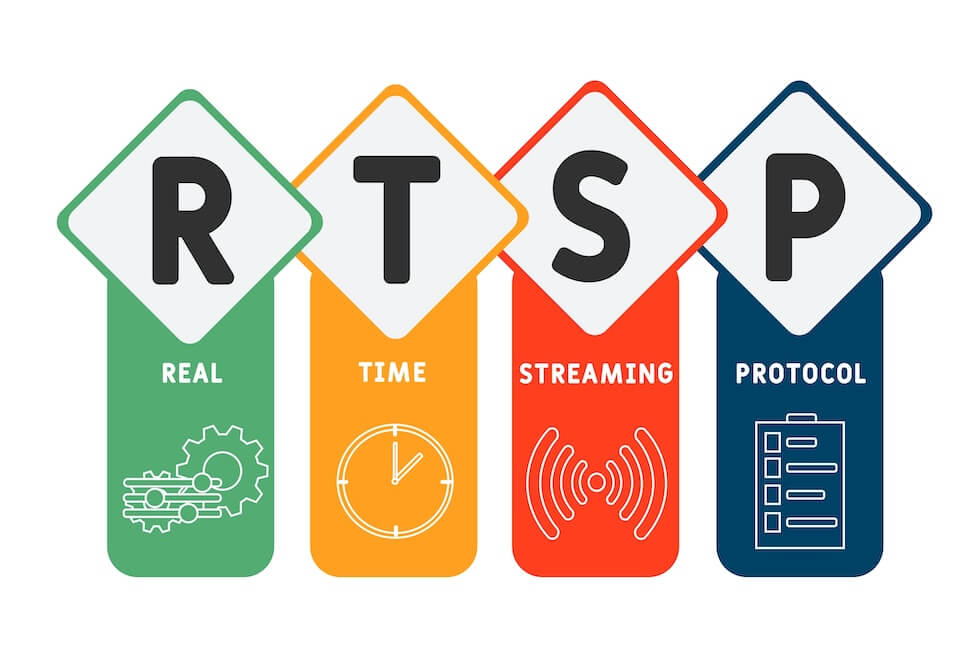What Is a Real-Time Streaming Protocol (RTSP)?
Real-time streaming is a core element of modern media consumption, ranging from video conferencing to live sports broadcasts and surveillance feeds. The need for instant delivery of media content has driven the development of several protocols, each serving a specific purpose in the delivery and control of live or on-demand media. One such protocol is a Real-Time Streaming Protocol (RTSP), which plays a pivotal role in controlling the streaming of multimedia content over a network. In this article, we will explore RTSP in detail: what it is, how it works, its key features, and why it’s still relevant in today’s fast-paced streaming landscape.
What Is RTSP?
What is a Real-Time Streaming Protocol? It is a network protocol designed to control the streaming of multimedia content, allowing users to interact with media in real-time. Developed in 1996 by the IETF (Internet Engineering Task Force), RTSP was designed to manage the streaming of multimedia content over a network. Unlike protocols that are solely responsible for the actual data transfer (like RTP – Real-Time Protocol), RTSP handles the control of the media stream.
RTSP allows clients to request media streams from servers, pause or resume playback, and even seek specific parts of a stream. It’s most commonly used in live streaming, IP cameras, and video-on-demand services.
In essence, RTSP acts like a remote control for media servers, giving users the ability to play, pause, and interact with the media in real-time.

How RTSP Works
RTSP follows a client-server architecture, where the client sends commands like “PLAY” or “PAUSE.” So, what is a Real-Time Streaming Protocol in essence? It’s the protocol that allows the server to process these commands and deliver or control the media accordingly.
Here’s a breakdown of how protocol for streaming like RTSP operates:
- RTSP Request and Response: When a client sends a request (such as “PLAY” or “PAUSE”), the server processes it and responds accordingly. RTSP uses HTTP-like methods, including PLAY, PAUSE, SETUP, and TEARDOWN.
- Media Transport: While RTSP controls the session, it often works in conjunction with RTP (Real-Time Protocol) for actual media transport. RTSP establishes the session, while RTP handles the real-time delivery of audio or video.
- Session Handling: Each session in RTSP is uniquely identified by a session ID, allowing clients to interact with multiple media streams simultaneously without interference.
For example, in a surveillance system, an RTSP command might instruct the media server to stream live video from an IP camera, while another command might pause the stream or jump to a specific frame.
Key Features of RTSP
RTSP offers essential features that make it an ideal solution for managing and controlling real-time media streams, especially in interactive and professional settings. So, what is a Real-Time Streaming Protocol’s key advantage? It provides precise playback control, allowing for seamless user interaction with the stream in real-time.
Playback Control
RTSP provides precise control over media playback, offering commands like PLAY, PAUSE, SEEK, and STOP. This feature is essential in applications where users need to interact with the media, such as live broadcasts or surveillance feeds, allowing real-time adjustments.
Session Management
Each RTSP session is uniquely identified, enabling independent control of multiple streams. This is particularly useful in environments where multiple media feeds need to be managed simultaneously, such as video surveillance systems or multi-camera live broadcasts.
Stream Synchronization
RTSP works in conjunction with RTP to synchronize different media streams, ensuring smooth playback of audio, video, or other multimedia content. This synchronization is critical in professional broadcasting or when mixing various media types in real time.
Low Latency
One of the defining features of RTSP is its low-latency performance, making it ideal for applications that require real-time media delivery. Whether it’s a live event or surveillance footage, RTSP minimizes delays, ensuring that the media reaches the audience with minimal buffering or lag. RTSP typically operates over TCP or UDP. While TCP ensures reliability, UDP is often used for real-time media where low latency is crucial, but with the risk of packet loss in unstable networks.
Scalability
RTSP servers can manage numerous simultaneous connections, which makes it scalable for large-scale deployments. For example, it’s suitable for handling high volumes of traffic in live streaming events or broadcasting scenarios where thousands of users might access the same stream.
RTSP vs Other Streaming Protocols
While RTSP has been a staple in real-time streaming, it is often compared with other protocols like HLS (HTTP Live Streaming), MPEG-DASH, and WebRTC. Here’s how RTSP stacks up:
- RTSP vs HLS: HLS is more commonly used for on-demand streaming and adaptive bitrate streaming, whereas RTSP is better suited for real-time interactions (e.g., live streams, surveillance). HLS relies on HTTP and uses a longer delay in stream delivery, making it less ideal for low-latency applications.
- RTSP vs MPEG-DASH: Both RTSP and DASH provide adaptive bitrate streaming, but DASH is primarily used for large-scale video-on-demand and supports HTML5 browsers directly, whereas RTSP is often used in specialized systems.
- RTSP vs WebRTC: WebRTC is a newer protocol designed for peer-to-peer communication. While WebRTC offers lower latency than RTSP, RTSP is still widely used in environments that require streaming from a server to multiple clients.
RTSP is best suited for scenarios where real-time control over media streams is essential, whereas protocol for streaming like HLS or WebRTC may be more appropriate for different use cases. In comparison, what is a Real-Time Streaming Protocol’s main strength? It excels in scenarios where minimal latency and real-time media control are necessary, such as live broadcasting or surveillance applications.
| Protocol | Best For | Latency | Playback Control | Browser Compatibility | Transport |
|---|---|---|---|---|---|
| RTSP | Surveillance, live broadcasts, real-time control | Low | Full (Play, Pause, Seek) | Limited (requires plugin or media player) | RTP over UDP/TCP |
| HLS | On-demand streaming, mobile/iOS devices | High (15–30s) | Limited (segment-based) | Excellent (native support) | HTTP |
| MPEG-DASH | VOD, adaptive streaming, HTML5 | Medium to High | Segment-based control | Excellent (HTML5) | HTTP |
| WebRTC | Real-time P2P communication | Ultra-low | Basic (depends on implementation) | Excellent (browser-native) | UDP/SCTP |
Use Cases and Applications of RTSP
RTSP finds application in various fields that require real-time media control, especially where low-latency is critical:
Surveillance and Security Systems
RTSP is widely used in IP cameras for live video streaming, providing real-time control over the footage. Security personnel can pause, seek, or review past footage from cameras, enabling fast responses to security incidents or enabling monitoring from multiple cameras simultaneously.
Professional Video Production and Broadcasting
In live broadcasting, RTSP allows media producers to manage multiple video feeds and ensure they’re synchronized. This is essential for real-time control during events such as sports broadcasts, news coverage, and concerts, where precise timing is crucial for a smooth viewing experience.
Live Sports and Event Broadcasting
RTSP plays a significant role in live sports streaming, where delays in the broadcast could impact the viewing experience. By using RTSP, broadcasters can stream video feeds from different cameras and synchronize the content for live audiences, offering minimal buffering and real-time interaction.
Smart Device Integration
RTSP is used by many smart devices like IP cameras and media players for real-time video and audio streaming. This allows users to control camera feeds remotely, watch live events, or even adjust playback settings using smartphones, tablets, or smart TVs. In IoT devices, RTSP is typically used in smart cameras, where it’s often paired with RTSP over SSL/TLS (RTSPS) to secure the media stream, ensuring the integrity and confidentiality of the content.
Video on Demand (VOD)
Although RTSP is often used for live streaming, it can also support on-demand video services. It allows users to request and control playback of content stored on a server, providing the ability to pause, rewind, or seek specific timecodes within a video.
Healthcare and Remote Consultations
In the healthcare industry, RTSP is used for telemedicine applications, enabling doctors and patients to have video consultations. The low-latency and high-quality video stream offered by RTSP ensures that medical professionals can assess patients remotely in real-time, even in critical situations.
Benefits of Real Time Streaming Protocols
RTSP offers several advantages that make it a preferred choice for real-time streaming, particularly in professional settings:
Low Latency
One of the biggest advantages of RTSP is its low-latency streaming capability. It is designed to deliver real-time content with minimal delay, making it ideal for applications like live sports events, video conferencing, and surveillance, where even slight delays can affect the experience.
Flexible Media Control
RTSP provides users with the flexibility to pause, seek, and resume media playback in real-time. This level of control makes it invaluable for applications that require interaction, such as security systems, video-on-demand services, and live event broadcasts where viewers or operators need control over the media flow.
Wide Compatibility
RTSP is supported by a variety of devices and platforms, including IP cameras, smart TVs, and media players. Its compatibility with numerous systems and devices ensures that it can be implemented in various environments without major compatibility issues, providing a versatile solution for real-time streaming needs.
Scalable and Efficient
RTSP is capable of handling a large number of simultaneous streams, making it scalable for large-scale deployments. It’s well-suited for applications like live broadcasts or video surveillance systems, where multiple users or devices might need access to the same stream without compromising performance.
Supports Both Live and On-Demand Content
RTSP is versatile enough to handle both live streaming and on-demand content. Whether it’s for a live broadcast or a pre-recorded video, RTSP can be used to deliver content efficiently, offering a seamless experience for users regardless of the content type.
Integration with Other Protocols
RTSP works seamlessly with RTP (Real-Time Protocol), which is responsible for media transport, ensuring high-quality and synchronized delivery of media streams. This integration is essential in environments where multiple media streams (audio, video, etc.) must remain perfectly synchronized, such as live broadcasts or interactive video platforms. RTSP is often used in conjunction with RTP over UDP, which delivers media content in real-time. While RTP ensures proper media delivery, the use of RTSP over SSL (RTSPS) adds a security layer, protecting streams from unauthorized access.
Challenges and Limitations of RTSP
Despite its benefits, RTSP does have its limitations:
- Bandwidth Intensive: RTSP’s reliance on continuous, real-time streaming can be bandwidth-intensive, especially for high-definition content.
- Reliability Issues: RTSP is dependent on stable network connectivity. Network congestion or instability can disrupt the streaming experience.
- Security Concerns: RTSP streams are often susceptible to unauthorized access, and encryption is required for sensitive content. RTSP can be secured using RTSPS (RTSP over SSL/TLS), which encrypts the media stream during transmission. However, securing RTSP streams requires proper certificate management and encryption, especially in environments handling sensitive content like healthcare or surveillance.
- Device Compatibility: While widely supported, some modern browsers and devices may not fully support RTSP, requiring additional plugins or workarounds.
RTSP Security Considerations
Given RTSP’s use in streaming sensitive content like surveillance footage, security is a crucial consideration:
- Stream Encryption: RTSP can use RTSPS (RTSP over SSL/TLS) to encrypt the media stream, ensuring that data transmitted over the network remains secure. RTSPS provides a secure channel for RTSP traffic by using SSL/TLS encryption. This ensures that sensitive media content remains confidential during transmission, which is especially critical in applications such as surveillance and remote medical consultations.
- Authentication and Authorization: Secure RTSP implementations can enforce user authentication before granting access to streams, protecting sensitive media from unauthorized users.
- Access Control: By implementing access control policies, RTSP servers can restrict who can view, pause, or modify streams, ensuring that only authorized users interact with the media.
Conclusion
Real-Time Streaming Protocols (RTSP) remain a key player in live media streaming, offering flexibility, low-latency control, and compatibility across various devices and platforms. Whether it’s for surveillance systems, professional video production, or streaming live events, RTSP continues to serve industries requiring reliable and responsive media delivery. As streaming technology evolves, RTSP’s role in providing seamless control over media streams remains crucial.
Elevate Your Streaming Experience with HostStage
If you’re looking to enhance your streaming infrastructure or require a reliable and scalable hosting solution, HostStage offers powerful services tailored for high-performance media delivery. We recommend the our Streaming Flux VPS line featuring up to 25 Gbps bandwidth. This plan is perfect for high-demand streaming applications, offering the reliability and scalability required for real-time media delivery. Choose HostStage today and elevate your streaming capabilities.




